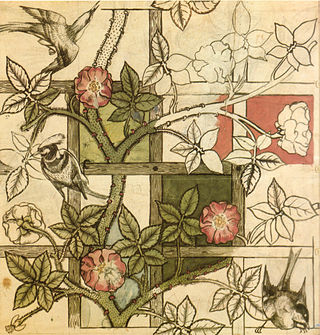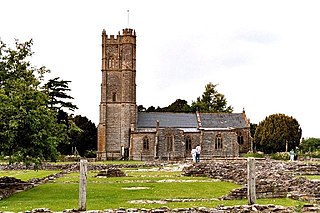
William Edwin Worrall (1877-1940) was a Staffordshire-born designer of fabric, pottery, glass and stoneware. He was the brother of the watercolour painter Thomas Frederick Worrall and shared similar artistic ability.

William Edwin Worrall (1877-1940) was a Staffordshire-born designer of fabric, pottery, glass and stoneware. He was the brother of the watercolour painter Thomas Frederick Worrall and shared similar artistic ability.
William Edwin Worrall was the middle of three sons born to blacksmith Thomas Worrall senior and Susannah Worrall, in Wednesbury, Staffordshire. [1] The family moved to Church, near Accrington in Lancashire and after leaving school, William became a cotton print designer. [2] Whereas his elder brother, Thomas, became a blacksmith and painted watercolours as a side interest, William made creativity his paid employment.
The 1891 census shows Worrall living with his mother and siblings in Church, Lancashire, working as an office boy in a cotton mill. [3] By 1901 he was still working in the mill but was a designer of cotton prints, [4] probably for F. Steiner & Company. Pattern books from Steiner in the collection of the Victoria and Albert Museum indicate the sort of designs that he created. [5] Worrall later moved to Cheshire, still designing fabric prints. [6] The England and Wales Register for 1939 shows that during the First World War, Worrall worked in the Ministry of Munitions, [7] but nothing of his work there is known. Information about his life during the early 1920s is similarly lacking, but by 1928 he was teaching pottery at the Chalice Well Crafts Guild in Glastonbury, Somerset, which had been founded in 1912 by Alice Buckton. [8] By 1932 Worrall was the chief craftsman there. [9] [10] [11] Worrall was living at that time in the nearby newly built house, 'Stone Down', along with historical writer, Thomas N. Wild and his wife. [12]

Worrall's years in Glastonbury were productive, and he demonstrated a move away from fabric design. He trained in pottery making under the renowned Bernard Leach, and Leach later named him as one of his principal students. [13] In 1931, Worrall was invited to demonstrate pottery techniques at the Selfridges department store in London, [14] and featured in an article in the American newspaper, Evening World. [15] He also became skilled in tile-making and bronze-work and was an early member of the Somerset Guild of Craftsmen which exists to this day. [16] [17] He was invited by the Board of Trade to submit items for the 1937 Paris Exhibition, and sent a dish, jug and beer mug for the rural industries section. The dish incorporated an image of Glastonbury Tor. [18] [19] [20] He became further known when he was commissioned to make a memorial of bronze set in stone to the famous Somerset author Walter Raymond, which was placed, and still is, in Yeovil Library. [21] He also notably designed the renovations of St Margaret's Almshouses in Taunton, [22] and played a significant role in life at Chalice Well in Glastonbury, being a member of that group's dramatic circle which performed plays, and he created the required stage scenery. He became very knowledgeable about local folklore, became a member of the Avalon Sister and Brotherhood, and gave lectures on the legend of Glastonbury and the Holy Grail. [23] [24] [25]
Worrall died in the Mary Hewetson Hospital, Keswick, in 1940 while staying in the Lake District. His death certificate shows that he was suffering from myocardial degeneration (lost function of the heart muscle) and his obituary in the Central Somerset Gazette states that he had been in the Lake District for three months in the hope that the clean air would improve his heart complaint. [26] [27] He is buried in St Kentigern's Church churchyard in Crosthwaite, on the outskirts of Keswick. There is a plaque to Worrall in St John's Church in Glastonbury on which the dedication reads: William Worrall Designer and craftsman of Stone Down Near Glastonbury Died November 9th 1940. RIP. The plaque consists of two of Worrall's handmade tiles and shows St. Christopher carrying the child Jesus. The newspaper obituary says that Worrall readily gave gentle counsel to those seeking spiritual guidance, and that it is the results from this work in the hearts of those people 'that is his best and truest memorial'.
Worrall's elder brother, Thomas, visited the grave in Keswick in 1947 and took the opportunity of painting nearby scenes.



The Arts and Crafts movement was an international trend in the decorative and fine arts that developed earliest and most fully in the British Isles and subsequently spread across the British Empire and to the rest of Europe and America.

Somerset is a ceremonial county in South West England. It is bordered by the Bristol Channel, Gloucestershire, and Bristol to the north, Wiltshire to the east and the north-east, Dorset to the south-east, and Devon to the south-west. The largest settlement is the city of Bath, and the county town is Taunton.
Glastonbury Tor is a tor near Glastonbury in the English county of Somerset, topped by the roofless St Michael's Tower, a Grade I listed building. The site is managed by the National Trust and has been designated a scheduled monument. The Tor is mentioned in Celtic mythology, particularly in myths linked to King Arthur, and has several other enduring mythological and spiritual associations.

Taunton is the county town of Somerset, England. It is a market town and has a minster church. Its population in 2011 was 64,621. Its thousand-year history includes a 10th-century monastic foundation, owned by the Bishops of Winchester, which was rebuilt as Taunton Castle by the Normans in the 12th century. Parts of the inner ward house were turned into the Museum of Somerset and Somerset Military Museum. For the Second Cornish uprising of 1497, Perkin Warbeck brought an army of 6,000; most surrendered to Henry VII on 4 October 1497. On 20 June 1685 in Taunton the Duke of Monmouth crowned himself King of England in a rebellion, defeated at the Battle of Sedgemoor. Judge Jeffreys led the Bloody Assizes in the Castle's Great Hall.

Glastonbury Abbey was a monastery in Glastonbury, Somerset, England. Its ruins, a grade I listed building and scheduled ancient monument, are open as a visitor attraction.

Bernard Howell Leach was a British studio potter and art teacher. He is regarded as the "Father of British studio pottery".

The term "ethical pot" was coined by Oliver Watson in his book Studio Pottery: Twentieth Century British Ceramics in the Victoria and Albert Museum to describe a 20th-century trend in studio pottery that favoured plain, utilitarian ceramics. Watson said that the ethical pot,"lovingly made in the correct way and with the correct attitude, would contain a spiritual and moral dimension." Its leading proponents were Bernard Leach and a more controversial group of post-war British studio potters. They were theoretically opposed to the expressive pots or fine art pots of potters such as William Staite Murray, Lucie Rie and Hans Coper.

Castle Cary is a market town and civil parish in south Somerset, England, 5 miles (8 km) north west of Wincanton and 8 miles (12.9 km) south of Shepton Mallet, at the foot of Lodge Hill and on the River Cary, a tributary of the Parrett.

Highbridge is a market town on the edge of the Somerset Levels near the mouth of the River Brue. It is in the county of Somerset, and is about 20 miles (32 km) northeast of Taunton, the county town of Somerset. No longer a market town, the market site is now a housing estate. Highbridge is about 7 miles (11 km) north of Bridgwater, the district's administrative centre. Highbridge closely neighbours Burnham-on-Sea, forming part of the combined parish of Burnham-on-Sea and Highbridge and shares a town council with the resort town. The 2001 Census recorded Highbridge's population as 5,986. In the 2011 Census the population of the town was included in the ward of Highbridge and Burnham Marine, which totalled 7,555.

The Diocese of Bath and Wells is a diocese in the Church of England Province of Canterbury in England.

Muchelney Abbey is an English Heritage property in the village of Muchelney in the Somerset Levels, England. The site consists of ruined walls showing the layout of the abbey buildings constructed from the 7th to 16th centuries, and the remaining intact Abbot's House. It is next to the parish church in which some of the fabric of the abbey has been reused.

St Margaret's Almshouses are part of a 12th-century leper colony in Taunton, Somerset, England.

Somerset is a county in the south west of England. It has a varied cultural tradition ranging from the Arthurian legends to The Wurzels, a band specialising in Scrumpy and Western music.

Glastonbury Lake Village was an Iron Age village, situated on a crannog or man made island in the Somerset Levels, near Godney, some 3 miles (5 km) north west of Glastonbury in the southwestern English county of Somerset. It has been designated as a scheduled monument.
Gerald Trump is an English cricketer, schoolmaster and the founder, and headmaster, of Edington School. He was a medium pace seam bowler who generally opened the bowling. He played for Devon and Somerset second XI between 1958 and 1977. He was captain of Devon between 1970 and 1972.

Described as "one of the most ambitious parish churches in Somerset", the present Church of St John the Baptist in Glastonbury, Somerset, England, dates from the 15th century and has been designated as a Grade I listed building.

Walter Raymond was an English novelist.

There are over 670 scheduled monuments in the ceremonial county of Somerset in South West England. The county consists of a non-metropolitan county, administered by Somerset County Council, which is divided into five districts, and two unitary authorities. The districts of Somerset are West Somerset, South Somerset, Taunton Deane, Mendip and Sedgemoor. The two administratively independent unitary authorities, which were established on 1 April 1996 following the breakup of the county of Avon, are North Somerset and Bath and North East Somerset. These unitary authorities include areas that were once part of Somerset before the creation of Avon in 1974.

Thomas Frederick Worrall (1872–1957) was a Staffordshire-born manual worker and watercolourist. He lived for a time in Lancashire and in the upper Calder Valley area of Yorkshire but spent most of his adult life in Barry, in South Wales, where he was also deeply involved in politics and stood for parliament in the general election of 1923 representing the Labour Party. He was the elder brother of the pottery and fabric designer William Worrall.